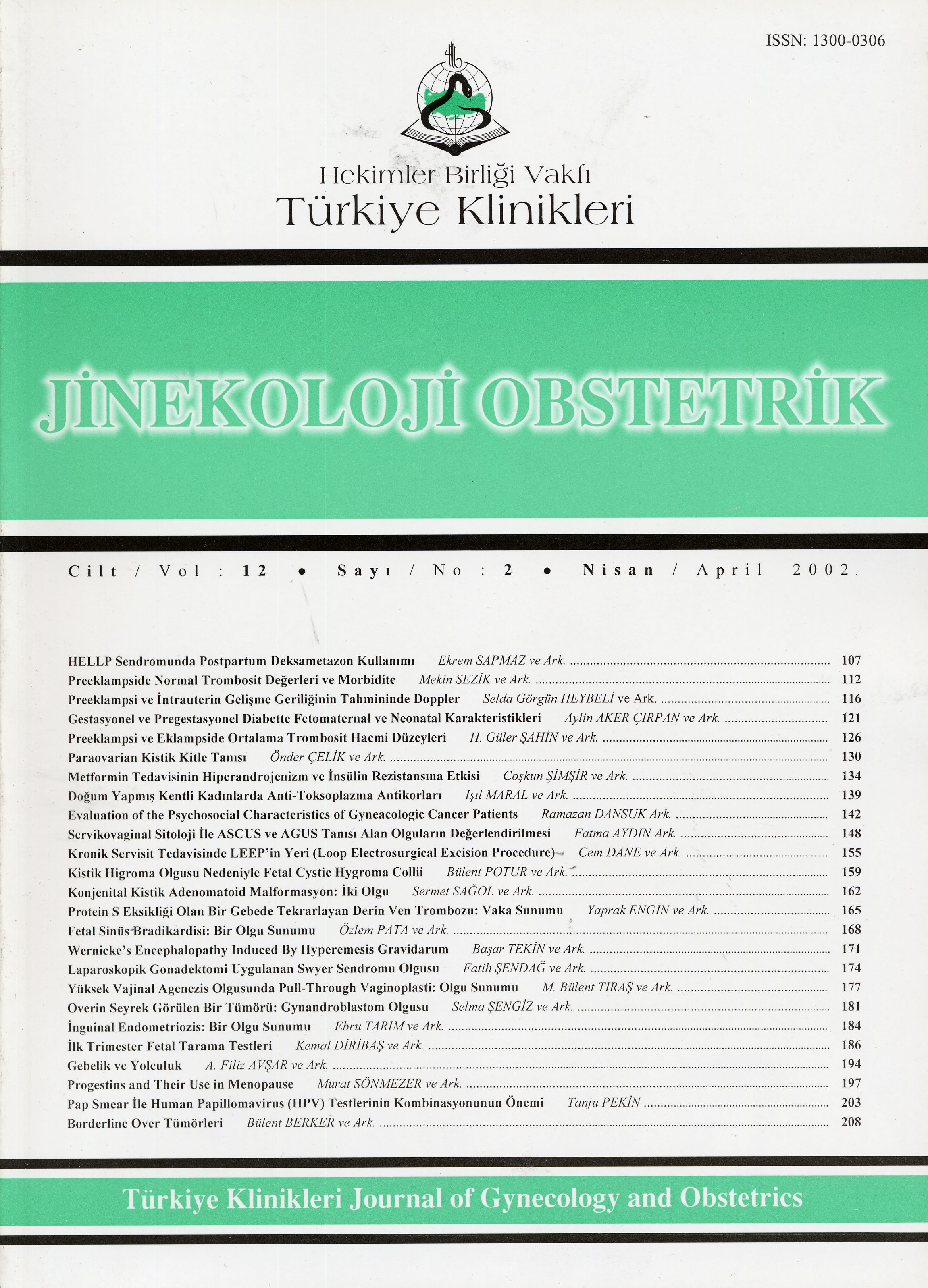Open Access
Peer Reviewed
ARTICLES
3646 Viewed2201 Downloaded
Laparoscopic Gonadectomy In A Patient With Swyer Syndrome
Laparoskopik Gonadektomi Uygulanan Swyer Sendromu Olgusu
Turkiye Klinikleri J Gynecol Obst. 2002;12(2):174-6
Article Language: TR
Copyright Ⓒ 2025 by Türkiye Klinikleri. This is an open access article under the CC BY-NC-ND license (http://creativecommons.org/licenses/by-nc-nd/4.0/)
ÖZET
Amaç: XY gonadal disgenezili olgulara yaklaşımın, bir vaka nedeniyle güncel literatür eşliğinde tartışılması . Çalışmanın Yapıldığı Yer: Ege Üniversitesi Tıp Fakültesi Kadın Hastalıkları ve Doğum Anabilim Dalı, Bornova, İzmir Olgu Sunumu: 26 yaşındaki olgu kliniğimize primer amenore yakınması ile başvurdu. Fizik muayenede dişi fenotipi ve normal dişi eksternal genital organlar saptandı. Transabdominal pelvik sonografide normal bir uterus ve fibrotik iki over izlendi. Postmenopozal düzeyde FSH ve LH seviyeleri, düşük estradiol seviyesi ve 46XY karyotipi saptanan hastaya Swyer sendromu tanısı ile laparoskopik gonadektomi uygulandı. Histopatoloji sonucu benign olarak geldi. Sonuç: Malign gonadal tümör gelişme riskinden dolayı fenotipik dişilerde Y kromozomu taşıyan gonadal doku tanı konduktan sonra ekstirpe edilmelidir. XY genotipi olması normal uterin ve endometriyal cevabı etkilemediğinden, oosit donasyonu ve in vitro fertilizayon yolu ile gelecekteki gebelik olasılığı düşünülerek uterusun korunması önerilmektedir.
Amaç: XY gonadal disgenezili olgulara yaklaşımın, bir vaka nedeniyle güncel literatür eşliğinde tartışılması . Çalışmanın Yapıldığı Yer: Ege Üniversitesi Tıp Fakültesi Kadın Hastalıkları ve Doğum Anabilim Dalı, Bornova, İzmir Olgu Sunumu: 26 yaşındaki olgu kliniğimize primer amenore yakınması ile başvurdu. Fizik muayenede dişi fenotipi ve normal dişi eksternal genital organlar saptandı. Transabdominal pelvik sonografide normal bir uterus ve fibrotik iki over izlendi. Postmenopozal düzeyde FSH ve LH seviyeleri, düşük estradiol seviyesi ve 46XY karyotipi saptanan hastaya Swyer sendromu tanısı ile laparoskopik gonadektomi uygulandı. Histopatoloji sonucu benign olarak geldi. Sonuç: Malign gonadal tümör gelişme riskinden dolayı fenotipik dişilerde Y kromozomu taşıyan gonadal doku tanı konduktan sonra ekstirpe edilmelidir. XY genotipi olması normal uterin ve endometriyal cevabı etkilemediğinden, oosit donasyonu ve in vitro fertilizayon yolu ile gelecekteki gebelik olasılığı düşünülerek uterusun korunması önerilmektedir.
ANAHTAR KELİMELER: Swyer sendromu, Laparoskopik gonadektomi
ABSTRACT
Objective: Discussion of the approach to the patients with XY gonadal dysgenesis regarding to current literature due to a case. Institution: Ege University, Faculty of Medicine, Department of Obstetrics and Gynecology, Bornova, Izmir Case Report: The patient who is 26 years old applied to our clinic with a complained of primary amenorrhoea. She had female phenotype and normal external genital organs on physical examination. Also, a normal uterus and two fibrotic ovaries were observed on transabdominal pelvic sonography. To the patient who had postmenopausal FSH and LH levels, low oestradiol levels and 46XY karyotype, with a diagnosis of Swyer syndrome, laparoscopic gonadectomy was performed. The hystopathological examination revealed no malignancy. Conclusion: In phenotypic females after the diagnosis of Y chromosome carrying gonadal tissue, this must be extirpated due to the risk of malignant gonadal tumour development. Since XY genotype does not affect normal uterine and endometrial response, preservation of uterus is proposed with a possibility of future pregnancy in a way of oocyte donation and in vitro fertilization.
Objective: Discussion of the approach to the patients with XY gonadal dysgenesis regarding to current literature due to a case. Institution: Ege University, Faculty of Medicine, Department of Obstetrics and Gynecology, Bornova, Izmir Case Report: The patient who is 26 years old applied to our clinic with a complained of primary amenorrhoea. She had female phenotype and normal external genital organs on physical examination. Also, a normal uterus and two fibrotic ovaries were observed on transabdominal pelvic sonography. To the patient who had postmenopausal FSH and LH levels, low oestradiol levels and 46XY karyotype, with a diagnosis of Swyer syndrome, laparoscopic gonadectomy was performed. The hystopathological examination revealed no malignancy. Conclusion: In phenotypic females after the diagnosis of Y chromosome carrying gonadal tissue, this must be extirpated due to the risk of malignant gonadal tumour development. Since XY genotype does not affect normal uterine and endometrial response, preservation of uterus is proposed with a possibility of future pregnancy in a way of oocyte donation and in vitro fertilization.
MENU
POPULAR ARTICLES
MOST DOWNLOADED ARTICLES





This journal is licensed under a Creative Commons Attribution-NonCommercial-NoDerivatives 4.0 International License.










